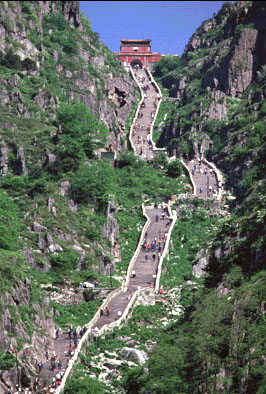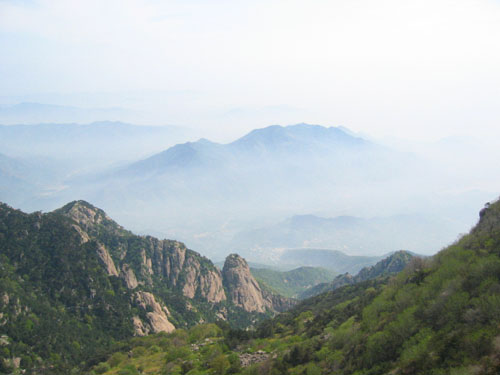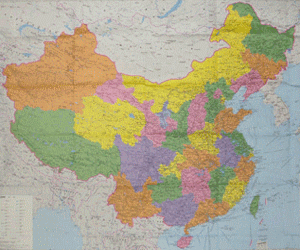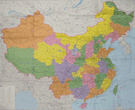|
|
Home
 China Travel
China Travel
 China
Travel Guide
China
Travel Guide
 Shandong
Shandong  Mt. Tai (Taishan)
Mt. Tai (Taishan) |
|
China Travel Guide: Shandong Province
Mt. Tai (Taishan) |
|
|
|
Mt. Tai (Tai'shan) |
|
Mt. Tai, Taishan, more than
345 miles in circumference, rises steeply and majestically in the middle
of Shandong Province about 45 miles from Jinan. Massive and awesome, it
has featured in many historic events throughout the ages, and has been a
rich source of inspiration for countless maxims, poetic allusions, and
literary works. To many people the mountain is a symbol of grandeur and
stability as shown, for example, in the popular Chinese saying, “As
solid as Mount Tai.”
|

Mt. Tai (Taishan) |
Tiankuang (Celestial Gift)
Hall, the main hall of the Dai Temple, consists of nine rooms with
double eaves, eight cornices and yellow glazed tile roofs. The frescoes
(10 ft. high and 170 ft. long) of life-like figures, covering the east,
west, and north walls are rare, outstanding works of art.
Jinshiyu Valley: Half a mile to the northeast of Doumu Palace is a huge
wall of rock (one 15th of a hectare) bearing an engraving of the Diamond
Sutra. Each character is more than a foot high. The forceful calligraphy
of this ancient inscription is regarded as the prototype of the bank
(placard) style.
Nantianmen (South Celestial) Gate: This is opposite the Beitianmen Gate
(the Northern Celestial Gate) and can be reached by a steep, winding
staircase. At the top is Mokong (Touching the Sky) tower with a stone
table bearing an inscription by Du Renjie, a Yuan Dynasty poet.
descendant of Confucius.

Mt. Tai (Taishan) |
|
|
|
Mt.
Tai Related Reports |
Mount Taishan : Close to perfect
Mount Taishan is a huge tourist attraction that
requires significant efforts to maintain.
Chitralekha Basu and Wang Qian find out more about
what is being done to preserve the peak.
One of the five sacred Chinese Taoist peaks, Mount
Taishan is a bit crowded at the top. Favored by
monks and emperors since Qin Shihuang (259-210 BC),
the mountain seems incredibly peopled - especially
at the Jade Emperor's Summit, 1,545 meters above sea
level.
Tourist traffic has multiplied over the years, from
1.7 million in 2004 to 3.4 million in 2011. As
footfalls increase, the task of protecting this
national treasure becomes more demanding.
Protecting Paleolithic rocks is no mean task. And
neither is preserving the ecological balance and the
spiritual ambience of a mountain that seems like a
homage to more than 2,000 years of Chinese culture,
which the historian Sima Qian (135-86 BC) saluted
and Tang Dynasty poet Du Fu (AD 712-770) marveled
at.
To find out if Mount Taishan was suffocating under
heavy tourist traffic, we recently visited the site.
Indeed, the summit was rather noisy. The courtyard
of the Goddess Bixia buzzed with pilgrims offering
prayers and fastening newer locks to an
ever-expanding brass pile of these, in the hope of
bringing luck and blessings to their families.
A bevy of people eagerly awaited their turns to be
photographed in front of the Sea-exploring Stone,
which bore the inscription, "Mount Taishan -
Mountain of Mountains".
A group broke into a synchronized drill and a song
about the greatness of the mountain and Shandong
province, where the peak is located.
All this was a bit at odds with the somber ambience
one would have expected at a mountain that,
traditionally, has served as a place of retreat for
Buddhist, Taoist and Confucian pilgrims.
The Mount Taishan Scenic Spots Management Committee,
which works with the local Tai'an government to
protect the mountain and develop its potential as a
tourist destination, is doing its bit.
As Wan Qinghai, its vice-director, told us, "We do
take some measures trying to maintain quietness at
the peak. The kiosks and tour guides on the mountain
are not allowed to use high-decibel loudspeakers.
Tourists are asked to lower their voices when they
step inside the temples at the peak. Actually, most
tourists are very devout and lower their voices on
their own."
Xu Luchang, who has been running a store at Hotel
Shen Qi on the peak for the last 10 years, says
tourists have indeed gotten more responsible - "they
don't litter the place with cigarette butts like
they used to".
The management committee gets a thumbs-up from him.
"They are working around the clock, in shifts,
employing more people in the peak seasons."
One of the 1,600-odd regular people employed by the
committee is garbage collector Sun Jiyu, who says
his task is getting lighter with time. He picks up
about 200 bottles a day in winter and more than
double that in summer.
"Nowadays, tourists use the bins rather than
littering," he says.
The more than 100 volunteers who serve as tour
guides and environmental watchdogs during peak
seasons have had a role in sensitizing tourists.
The Tai'an City Community Volunteers' Association
sends a huge number of these people - students,
workers, retirees and officials - to work alongside
the staff.
As Hua Liangping, of the Association, says: "The
idea is to lead by example, rather than trying to
impose. We ask volunteers to pick up the garbage
that a visitor might have, carelessly, dropped on
the ground. But if they find a visitor smoking, they
ask him to stop, as smoking is strictly prohibited
on the mountain."
Checking the trees for pests is a major thrust of
protecting the expansive green cover on Mount
Taishan. It was quite bare until 1999, when a
forestation drive was launched.
"Today, 82.4 percent of the total 12,000-hectare
area is covered by forests while 94 percent is
covered by foliage," Wan says.
Sun Xugen, professor of Plant Protection College of
Shandong Agriculture University in Tai'an, says
there is a potential threat from pests, such as the
fall webworm moth and pinewood nematode, which,
although not yet found on Taishan, have been located
in the mountains of Zibo, only 200 km away.
A provincial pest control and research center has
been established at Shandong Agriculture University
to study treatments of the damage caused by pinewood
nematodes.
Sometimes, the research center conducts experiments
on Mount Taishan with the staff of the Pest Control
and Quarantine Station at the mountain.
The man in charge of the arduous task of managing a
team of 200 staff members who run checks - working
both day and night shifts - on Taishan's trees is
Shen Weixing, director of the Pest Control and
Quarantine Station.
Shen, who often scrutinizes the trees at night, has
introduced other measures to keep the pests at bay
that seem to be working.
"There are checkpoints at every gateway to prevent
people from carrying wooden furniture on the
mountain, as these are potential carriers of pests.
Only environmentally friendly pesticides are used,
rather than chemical-based products. We often use
one pest to kill another," Shen says.
Bird species like the magpie and the swallow have
been brought in to help kill pests. And trees like
oaks, pines and firs that better suit the
mountainous terrain were planted in recent years to
ensure a greater ecological balance, Shen says.
"The fact that Taishan is being reforested is very
impressive," says John Wallace from the Asia Pacific
Journalism Center in Melbourne, who has run several
international conferences on climate concerns.
He also lauded the fact that only electronically
powered vehicles were allowed to go up - and in
limited numbers.
"People were taking rocks from the streams," he
says. "That's been checked. In places, walls have
been built to keep the rocks from falling off. It's
great to see good policies are now in place."
Some of the amazingly colorful stones at Taishan -
some formed 2.8 billion years ago - around Peach
Blossom Valley gateway (see sidebar) were under
layers of scum for years. These were cleaned up, at
the cost of 50 million yuan ($7.9 million),
according to Wan, revealing the mystifying patterns
created on them were made through tectonic shifts.
"We have also built 23 dams to channel more water
into the streams," Wan says.
Since the clean-up, visitors have stopped throwing
trash into the stream.
"Earlier, the streams would get clogged up because
rubbish thrown in them accumulated in the riverbed.
Now, as you can see, the streams are absolutely
crystal clear," Hua says.
"Generally speaking, the ecological balance around
Mount Taishan is changing for the better," professor
Sun, of Shandong Agriculture University, says.
It's not perfect yet, but there seems to be a
concerted effort to get there.
(Source: China.org.cn 12-0601) |
|
|
|
|
|
|
|
|
|
|
|
ADVERTISEMENT
 |
|
|
|
|
ADVERTISEMENT
 |
|
|
|
|
|
|
|






